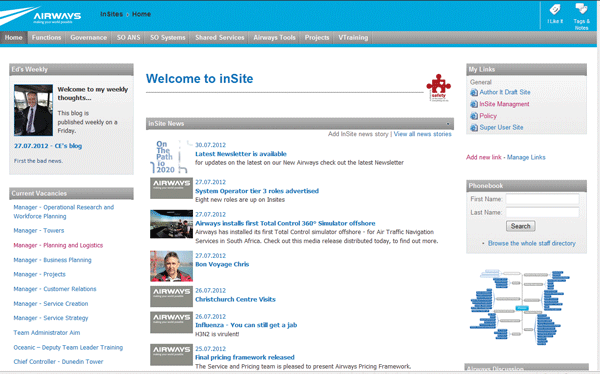Airways NZ flies ahead with ECM

A three year project to utilise SharePoint 2010 to integrate enterprise content management with a rejuvenated intranet at Airways NZ got off to a shaky start when disaster struck.
Airways New Zealand is a State-owned Enterprise (SOE) with over 750 staff and responsible for managing over one million aircraft movements annually within NZ’s 30 million sq. km of controlled airspace.
After a year spent in planning and scoping the project, budget approval was given in February 2011. However the initial deployment coincided with the disastrous Christchurch earthquake.
Airways NZ Quality Manager Christine Warren said “We received final approval in February 2011, and on 22 February the Christchurch earthquake hit.”
Christchurch is Airways NZ’s largest operational location, so the earthquake had a direct effect on staff and operations. There are also offices in Auckland and Wellington.
Along with Airways NZ’s internal MIS staff, NZ consultants Information Leadership were set to play a major role in the SharePoint deployment. Others involved were Canterbury Business Solutions and Streamliners.
“The day before the earthquake hit I had put my hand on my heart and said the project will be delivered on time and on budget, without a thought of the earthquake and 10,000 aftershocks.
“It affected us and the whole team that were due to manage this project,” said Warren.

At the controls of the Airways NZ developed Total Control Simulator which gives a full 360° uninterrupted view of the airfield and includes both tower and radar simulation.
“All of the project group worked collaboratively to implement iWorkplace, SharePoint, Colligo, AuthorIT and IntegrateIT all around the earthquake.”
Airways NZ started its SharePoint 2010 journey with the vision of providing a seamless intranet, document and records management experience to users.
In an organisation characterised by risk and quality management disciplines the need for an agile, iterative approach has had to be tempered with strong process and risk management. At the same time, the usability bar needed to be set high, in order to gain the active support of a wide range of teams.
The majority of airways records were previously stored in Windows folders. Permanent records, like maps and drawing are held in application specific databases. Operational procedure were managed centrally and distributed via the intranet.

The Airways NZ home page.
Warren explains that the journey began in 2009 when a need was identified to improve operational documentation.
“This is a critical function that governs how we deliver procedures to air traffic controllers and technicians that look after equipment. It needs be accurate and delivered at the right place at the right time.
SharePoint 2010 was identified as the platform to deliver this document management capability and also provide an upgrade to the existing intranet. This existed on Windows IIS with an SQL backend, custom written .asp apps for workflow, and Dreamweaver-based content updating. Most if not all content was published via the Webmaster.
At the same time, Airways NZ MIS Group was underway with an upgrade to IT infrastructure, which included additional SAN storage to support SharePoint, upgrading all desktop PCs to Office 2010 and Internet Explorer 8 and implementation of WAN accelerators between the main sites.
Hardware was virtualised and integrated into a SAN based storage environment.
The desktop application suite was mostly Office 2010, with some users still on Office 2007 – SharePoint and Office interaction was seen as important for both user acceptance and continuity of experience.
In tandem with the SharePoint rollout, the Colligo Pro Email and File Manager product has been implemented to integrate with Exchange 2007. This was previously integrated via cdoMail .asp calls in the old system.
“I wanted to expand the component content management system that pushed out policies and procedures to air traffic controllers,” said Warren.
The previous solution was to host these on the InSite intranet with hardcopy manuals in all locations. The document management process was very labour intensive. Each amendment was distributed and acknowledged manually with hard copy signatures.
“AuthorIt, deployed by Emma Harding from Streamliners, is at the heart of our new operational documentation management system,” said Warren.
“We can link the CAA Rules parts to our operational documentation using OBIEE (Oracle business intelligent enterprise edition) and provide an operational documentation dashboard for each group within Airways. Next year we intend to push the Air Traffic Control (ATC) procedures to electronic devices – e.g. iPads. The key being push. Today our iPad users are required to pull the information onto their devices.
“The future push design will include acknowledgement workflows – Have you read and understood the instruction, etc.”
Airways also developed a new portal for the Civil Aviation Authority New Zealand (CAA NZ). This portal provides CAA NZ with direct access to secure operational information. Single sourcing information had improved communication between CAA NZ and Airways. Both Airways and CAA NZ will have full confidence that each is looking at the most current version of the document.
Airways developed a secure means to provide business units or project team with a Joint Venture (JV) Hub. The JV hubs provide an effective means for collaboration with customers, stakeholders of JV partners.
In addition to this the Director Portal was upgraded to work on the SharePoint platform.
Being a state-owned enterprise, a key requirement was ensuring that the new ECM platform complied with New Zealand’s Public Records Act (PRA).
“Not only did we have to get the right information to the right people at the right time, we had to do it with a methodology that complied with this piece of legislation,” said Warren.
PRA compliance has been achieved with the addition of Information Leadership’s IWorkplace product which provides a record retention policy to SharePoint 2010.
Sarah Heal, Director with Information Leadership, has worked on over 40 implementations of SharePoint and iWorkplace in New Zealand.
“Airways NZ was a unique prospect that presented some significant challenges,” said Heal.
“Their level of focus on quality is completely off the scale, which is as you’d expect as you can’t be casual about airway control. They have a huge focus on quality and process, and their people are very busy, so while we were implementing the rollout we wanted to consult them and involve them, but not take too much of their time.”
The geographically diverse nature of the organisation also presented additional challenges. In addition to the three main centres in Wellington, Christchurch and Auckland, Airways NZ operates at 17 regional sites and internationally.
“Airways has always been good at process management and managing our business, but we did not have a lot of SharePoint skills,” said Warren. Airways NZ turned to Information leadership to design and build the SharePoint farm and infrastructure, as well as deliver records management compliance with the PRA.
“We aimed to build as much as possible using out of the box SharePoint, and many functions such as contracts and HR are common to many other organisations, so we were able to bring in preset components,” said Heal.
However Airways NZ had some unique requirements.
Information leadership developed a taxonomy and information architecture before commencing the core build of SharePoint.
“It took us six months to build our taxonomy. In our shared G drives we had a huge percentage of duplicated information. One of our key goals was we wanted 750 users to navigate to same site for the same information,” said Warren.
“The investment in the taxonomy was large. We began with a skeleton framework from Information Leadership. The skeleton included best practices for common processes like Finance, Human Resources, Legal.
“The consultation process with staff was extensive. There is a key learning here between the will (bringing people with you) and the way (technical approach). Information Leadership’s methodology is robust but it is difficult to get people excited about designing a taxonomy. Showing people how another organisation progressed from blank page to deployed site was rarely effective. Taxonomy is neither exciting nor fun.
“Next time around I would invest in training key staff (SuperUsers) in Information Leadership methodology right up front. Having 20 odd staff who understood their own business and SharePoint and Information Leadership development methodology would ensure at least one person in each critical area of the business could get excited about taxonomy design.”
“The SharePoint intranet and document and records management platform work together to provide virtual workplaces,” said Heal.
“There are a number of components to the virtual workplace and it was important for us to get the combination right for Airways NZ.
“In any business there are things we have to do as part of our job, there are business processes, document control, email management, drawings and photos.
“Then there is the reference and know-how information, the forms and the templates, the knowledge base. In many cases we don’t want to look at the information, we want to know who we should talk to, who has the expertise, who worked on this project.
“The virtual workplace needs to provide a mechanism for people to connect to each other.”
SmartFolders were used to provide customised views of case files, a series of files essentially about the same thing, such as employees, assets, and projects.
“Case folders are normally a security and control nightmare to manage, SmartFolders helps devolve management to local administrators without exposing the whole SharePoint system, and supports retention and disposal,” said Heal.
SmartFolders are automatically generated from a list of cases, to which you can add various security and permissions based on metadata. They can also be automatically closed or moved to inactive areas based on metadata.
Technicians and engineers go to an Asset site for managing assets and there is a corporate governance area for the board of directors and executive group.
A process management site integrates AuthorIT (Component Content System) for operational documentation and a relationship management site is where all documents relating to a specific customer or a specific supplier, such as Airways biggest customer Air New Zealand, is managed.
Commercial contracts are in a site with secure lockdown and access controls.
“We have used SmartFolders to push case file management down to end users,” said Warren.
All staff can store emails and documents in folders in case files and know it will not be visible to staff who are not authorised.
“Initially we thought two staff would be sufficient to administer the look and feel of SharePoint, a Web Coordinator and Information Coordinator,” said Warren.
“However many staff found it difficult to adjust to the new system, or refused to use it. We trained Super-users in three main locations and put 20 people through Information Leadership’s Power User course. All teams now have access to someone who can add metadata, bring a view to the left hand navigation and enhance the end user experience.
“You need to have a good mix of skills across the organisation before you deploy SharePoint. Floor walkers are effective communicators who are confident with how to use SharePoint. Super User can enhance the experience of SharePoint with updating view, metadata etc.
“Today we manage all SharePoint training in house. We provide a tailored course across the business. The course can focus on a specific skill (How to create a list) or mirror the power user course delivered by Information Leadership.
“Taking ownership in how to use and manage SharePoint is critical to the success of your deployment. This goes beyond the project team taking ownership from the consultants ownership has to be with the business units using SharePoint.
“To be honest, the wide acceptance of SharePoint across the organisation still has a long way to go. The earthquakes, loss of staff, and other issues have caused us problems throughout the project.
“We have a number of learnings from the project, and one of them is that it was difficult to implement the project at different paces through the organisation.
“Technically the project has gone relatively well, but user acceptance is still not at the level we would like. That is our next challenge, and we’ll make sure that our staff are well supported to utilise SharePoint if they are having issues with it.”
